Input interpretation

ethylamine
Chemical names and formulas

formula | C_2H_5NH_2 Hill formula | C_2H_7N name | ethylamine IUPAC name | ethanamine alternate names | 1-aminoethane | aminoethane | ethanamine | monoethylamine mass fractions | C (carbon) 53.3% | H (hydrogen) 15.7% | N (nitrogen) 31.1%
Lewis structure
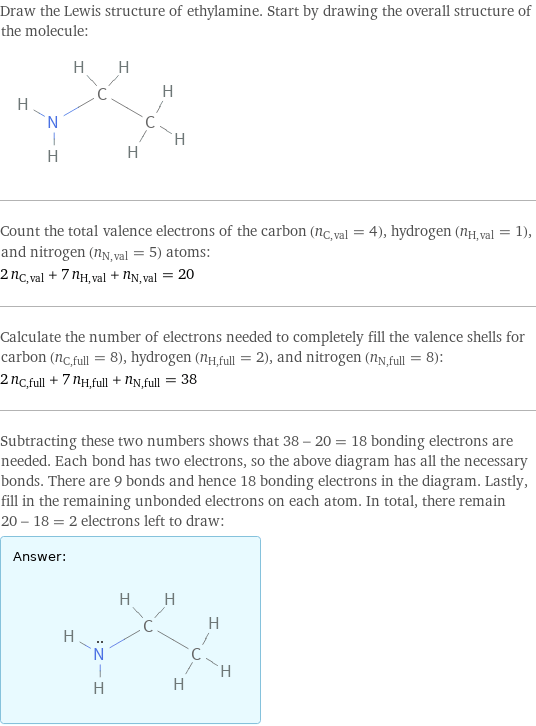
Draw the Lewis structure of ethylamine. Start by drawing the overall structure of the molecule: Count the total valence electrons of the carbon (n_C, val = 4), hydrogen (n_H, val = 1), and nitrogen (n_N, val = 5) atoms: 2 n_C, val + 7 n_H, val + n_N, val = 20 Calculate the number of electrons needed to completely fill the valence shells for carbon (n_C, full = 8), hydrogen (n_H, full = 2), and nitrogen (n_N, full = 8): 2 n_C, full + 7 n_H, full + n_N, full = 38 Subtracting these two numbers shows that 38 - 20 = 18 bonding electrons are needed. Each bond has two electrons, so the above diagram has all the necessary bonds. There are 9 bonds and hence 18 bonding electrons in the diagram. Lastly, fill in the remaining unbonded electrons on each atom. In total, there remain 20 - 18 = 2 electrons left to draw: Answer: | |
3D structure
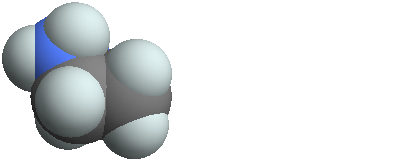
3D structure
Basic properties

molar mass | 45.08 g/mol phase | gas (at STP) melting point | -81 °C boiling point | 16.6 °C density | 0.68 g/cm^3 (at 20 °C) solubility in water | miscible
Units

Gas properties (at STP)
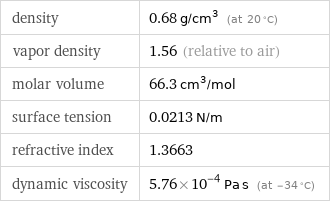
density | 0.68 g/cm^3 (at 20 °C) vapor density | 1.56 (relative to air) molar volume | 66.3 cm^3/mol surface tension | 0.0213 N/m refractive index | 1.3663 dynamic viscosity | 5.76×10^-4 Pa s (at -34 °C)
Units

Thermodynamic properties
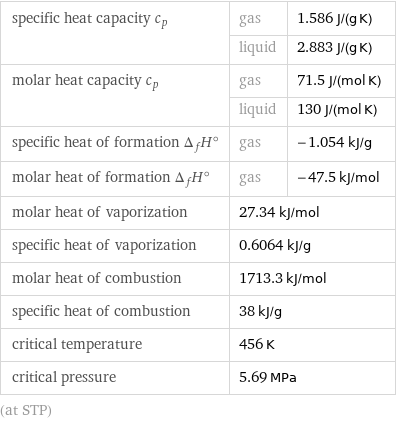
specific heat capacity c_p | gas | 1.586 J/(g K) | liquid | 2.883 J/(g K) molar heat capacity c_p | gas | 71.5 J/(mol K) | liquid | 130 J/(mol K) specific heat of formation Δ_fH° | gas | -1.054 kJ/g molar heat of formation Δ_fH° | gas | -47.5 kJ/mol molar heat of vaporization | 27.34 kJ/mol | specific heat of vaporization | 0.6064 kJ/g | molar heat of combustion | 1713.3 kJ/mol | specific heat of combustion | 38 kJ/g | critical temperature | 456 K | critical pressure | 5.69 MPa | (at STP)
Chemical identifiers
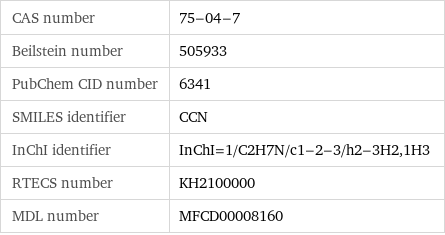
CAS number | 75-04-7 Beilstein number | 505933 PubChem CID number | 6341 SMILES identifier | CCN InChI identifier | InChI=1/C2H7N/c1-2-3/h2-3H2, 1H3 RTECS number | KH2100000 MDL number | MFCD00008160
NFPA label

NFPA label
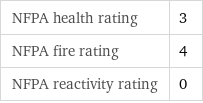
NFPA health rating | 3 NFPA fire rating | 4 NFPA reactivity rating | 0
Safety properties
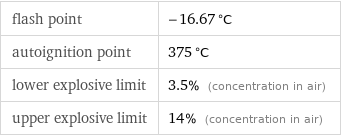
flash point | -16.67 °C autoignition point | 375 °C lower explosive limit | 3.5% (concentration in air) upper explosive limit | 14% (concentration in air)

DOT hazard class | 2.1 DOT numbers | 2270
Toxicity properties

odor | ammonia-like odor threshold | 0.95 ppm threshold limit value | 5 ppmv

RTECS classes | primary irritant